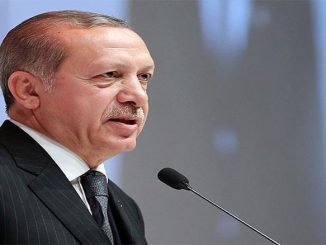
To spite the Turkish government, Al Arabiya Network, funded by the UAE and Saudi Arabia, has chosen to promote an anti-Turkey narrative on the 1915 events related to the Armenian issue.

While Armenian Orthodox Patriarch in Istanbul Sahak Maşalyan slammed the use of the 1915 events as a political tool by third parties and emphasized “the importance of building bridges of friendship and sincerity between Turkish and Armenian people in order to have a clear understanding and evaluation of the historical events”, the Saudi/Emirati-funded Al Arabiya Network blatantly used the 1915 events related to Armenians as a political tool to settle accounts with the Turkish government.
In reference to a report that it has published on its website, Al-Arabiya Network tweeted, saying, “Among the Armenians who were arrested during the period from 24 to 25 April 1915, only a dozen were able to return to Constantinople after the end of the war, where the majority were killed by the Ottomans, either through direct executions or under torture in prisons. #Armenian Genocide #Historical stories”.
Al-Arabiya Network on 24 April 2021 published a report titled, “The Armenian geocide .. With the execution of intellectuals … the Armenian genocide broke out, where 1.5 million Armenians were killed … Most of those arrested between 24 and 25 April 1915 were executed.”
The report, prepared by journalist Taha Abdel Nasser Ramadan, starts as follows:
“During the nineteenth century’s last decade, the Armenians living under the Ottoman Empire suffered from the horrors of the aggressive policy of Sultan Abdul Hamid II. After the Ottoman defeat at the hands of the Russians in 1878, Ottoman officials accused the Armenians of supporting the Russians and conspiring against the Sultanate, to start a systematic anti-Armenian extermination campaign that culminated during World War I. “
The Al Arabiya report continues, saying:
“During the period of the reign of Sultan Abdul Hamid II, who took over in 1876, between 1894 and 1896, the Ottomans murdered about 250,000 Armenians in the so-called “Hamidian massacres”. After the Young Turks Revolt, with Turkish nationalist tendencies, the Armenians living in Cilicia were subjected in 1909 to a massacre that claimed the lives of 30,000 of them. These massacres were preceded by the horrors of the Armenian genocide in World War I, which claimed the lives of about 1.5 million Armenians, that broke out, according to most historians, on April 24, 1915, in coincidence with the arrest of Armenian thinkers and intellectuals in Constantinople.
Under the subheading, “Arrest of intellectuals”, the Al Arabiya report says:
“Talaat Pasha, the Ottoman Interior Minister at the time, gave orders to start the arrest of Armenian intellectuals in Constantinople at around eight o’clock in the evening on April 24, 1915. During the night between the 24th and 25th of the same month, the Constantinople police under Badri Pasha arrested 235 to 270 Armenians, including doctors, engineers, journalists, lawyers and professors.
“At first, the detainees were held in the Interior Ministry’s prisons and corridors for one day to determine their exact identities before they were later transferred to other places in the Central Prison. After this first wave during the night between April 24 and 25, the Constantinople police continued arrests and subsequently arrested another 600 Armenians. During the following months, the number of Armenian intellectuals increased to reach 2,345 individuals, most of whom had nothing to do with political activities,” the Al Arabiya report continues.
Under the subtitle, “Executions and Intervention of American Ambassador”, the report says:
“With passing the displacement law on May 29, 1915, most of the remaining Armenian intellectuals in the prisons of Constantinople were sent to the Levant, which was then “occupied” by the Ottomans. Meanwhile, another section of the Armenian detainees, estimated at 220 individuals, according to a list of the Ottoman Interior Ministry, was transferred to Ankara, where they were divided into two divisions, the first was sent to Çankırı, and the second to Ayaş. After being “kidnapped” for months, most of those who were sent to Ayaş were executed, as only 10 of them returned to Constantinople during the following years.
“In Ayaş prison, the Ottomans separated a number of Armenian detainees, such as Doctor Nazaret Daghavarian and journalist Sarkis Minassian, and sent them to a military court. In the midst of these events, those intellectuals were executed by Ottoman paramilitary groups led by the mercenary Circassians Ahmed of Macedonian origins,” the report adds
Then, Al Arabiya report says:
“Thanks to the intervention of a number of prominent and influential figures with the Ottoman Empire, such as American Ambassador Henry Morgenthau, the Ottoman authorities agreed to release a number of detainees, estimated at 12 persons, who were in Çankırı and allowed them to return to Constantinople, notably the famous composer Komitas, who spent the last 20 years of his life in a sanatorium after his mental capacity deteriorated due to what happened to the Armenians.
Under the subheading, “Only Dozens Survived the Massacre”, the report says:
“Among the Armenians who were arrested during the night between April 24 and 25, 1915, only a dozen were able to return to Constantinople after the end of the war, while the majority were killed by the Ottomans, either through direct executions or under torture in prisons.”
The Al Arabiya report concludes, saying:
“Among intellectual Armenian figures who were executed at the time by the Ottomans, as history states, there were Khachatur Malumian, a journalist, Aram Andonian, a historian, Dikran Chökürian, a writer, and Armen Dorian, a poet.”



